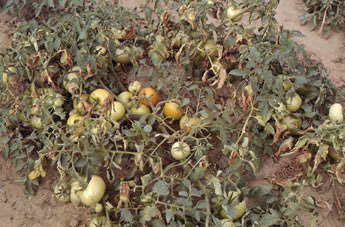The tomato plant, although sometimes perceived as a vegetable, is actually a fruit and originates from South America. Today there are all kinds of different varieties of tomatoes and they are grown all over the world. Most tomatoes are grown today in Southern Europe, Asia, and the United states but with the right set up you can grow this popular garden fruit just about anywhere. However as with any plant there are certain diseases you should know about when growing tomato plants. In this article we will talk about the tomato disease known as verticillium wilt and what you can to help prevent it from attacking your plants.


 Verticillium wilt is a disease caused by a fungus, Verticillium albo-atrum, which lives in the soil. It is often confused with fusarium wilt, bacterial canker, or early blight. Symptoms are similar in all these diseases.
Verticillium wilt is a disease caused by a fungus, Verticillium albo-atrum, which lives in the soil. It is often confused with fusarium wilt, bacterial canker, or early blight. Symptoms are similar in all these diseases.
The fungus works its way up through the plant’s roots, clogging water-conducting tissue in the stem. It spreads a toxin that wilts and spots leaves and prevents water from reaching branches and leaves, starving the plant. Infected plants usually survive the season but are stunted. If they produce any fruit, it’s small and underdeveloped.
Verticillium wilt is a soil-borne fungal disease that results in the yellowing, and eventual browning and death of foliage, particularly in branches closest to the soil. The wilt starts as yellow, V-shaped areas that narrow at the leaf margins. These yellow areas grow over time, turn brown, and then the leaf dies. Often, entire branches are infected.
It affects hundreds of different species of plants but some plants are immune such as ferns. Luckily the fungus is harmless to humans. The fungus lives in the soil and attacks plants with particularly stressed roots. The symptoms of verticillium wilt in tomato plants can be seen in the leaves. A tomato plant's leaves will wilt die, and fall off, and as the fungus progress the plant will become stunted and the tomato fruit will have yellow shoulders. The wilting and spotting of the tomato's leaves is caused by a toxin that the fungus produces. To diagnose if your tomato plant has verticillium wilt make a vertical slice on the main stem just above the soil. If you see a brown color tissue under the bark this discoloration can mean your plant has the fungus. Unlike other fungi that attack tomato plants the Verticillium wilt fungus is unique in the sense that it rarely extends more than a foot up from the soil.
Despite the sickly appearance of verticillium wilt-infected branches, often the upper part of the plant will continue growing, though growth will be stunted. Tomatoes that are growing on infected branches will often drop before reaching maturity, or they will be sunburned because of the lack of shade that the foliage would have provided. Even on branches that are not showing signs of wilt, the tomatoes will be smaller than normal, and often develop yellow shoulders.
When compared with early blight. Spots from early blight develop concentric circles; verticillium spots do not.
When compared with bacterial canker. Verticillium symptoms encircle the entire plant. Those infected with bacterial canker tend to show symptoms on just one side.



The fungus works its way up through the plant’s roots, clogging water-conducting tissue in the stem. It spreads a toxin that wilts and spots leaves and prevents water from reaching branches and leaves, starving the plant. Infected plants usually survive the season but are stunted. If they produce any fruit, it’s small and underdeveloped.
About
Symptoms
- Yellow spots appear on lower leaves, followed by brown veins. Leaves then turn brown and fall off. Infection pattern often resembles a V-shape. Symptoms progress up the stem.
- Plants may wilt during the day and recover at night.
- Interior of main stem (when split) shows discolored streaks about 10-12 inches above the soil line, the result of plugged water-conducting tissue.
- If cool conditions persist, the plant may die.
- The fungus thrives in cool temperatures and when soil is moist and not too warm (60-75ºF).
- It can attack at any stage in a tomato plant’s growth, but is most common when plant is producing fruit.
- Plants in poorly drained soil are more susceptible to infection than those in well-drained soil. Wet soil allows the fungus to multiply and move up through the tomato plant’s water-conducting tissue.
When compared with fusarium wilt: Verticillium develops more slowly than fusarium wilt. Yellowing is less dramatic with verticillium and encircles the entire plant, while those infected with fusarium tend to show symptoms just on one side. Interior stem discoloration extends just 10-12 inches high in tomatoes infected with verticillium wilt, but all the way up the stem in those infected with fusarium wilt.
When compared with early blight. Spots from early blight develop concentric circles; verticillium spots do not.
When compared with bacterial canker. Verticillium symptoms encircle the entire plant. Those infected with bacterial canker tend to show symptoms on just one side.
Prevention
- Rotate crops. The verticillium fungus can survive indefinitely in the soil. Plant tomatoes no more than once every four years in the same spot. Avoid planting other Solanaceous crops (potato, pepper, and eggplant) in the same area, too – they are susceptible to the fungus.
- A “V” listed after the variety name on its label indicates its resistance to the verticillium fungus.
- Plant tomatoes in well-drained soil.
- Remove and destroy affected plants at the end of the season.
Control
- To date, there is no chemical treatment available.
- To slow the disease, use fertilizers lower in nitrogen and higher in potassium.
- Destroy infected plants.
Tidak ada komentar:
Posting Komentar